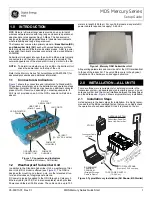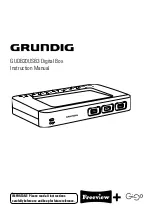
10
Consult lightning protection and station grounding information in the ARRL handbooks, or by
referring to the NEC (National Electric Code). The DX Engineering website also has technical and
product information listed under “Lightning Protection and Grounding.” Use lightning surge
protectors for the coaxial cable feedline and control lines.
Sizing the Array
When using active elements, the array side length can be as small as 1/10 wavelength and up to
about 1/2 wavelength on the highest frequency to be used. Sizes below 1/10 wavelength result in
unusable array sensitivity in the most desired bands. Making side lengths larger than 1/2 wavelength
on the highest frequency will split the main lobe and cause pattern and front-to-back degradation.
Determine the size of the array by considering the availability of appropriate space, frequency
coverage desired and the near proximity to undesirable noise sources, transmitting antennas and
other structures.
If there are no space constraints, follow the array side length recommendations in
Table 2
for
excellent performance. Side lengths longer than the optimal lengths shown will move the peak
sensitivity of the array toward the lower frequency. For example, if you are most interested in 160m
performance with occasional use on 80m, make the side lengths longer than the optimal 98 feet
shown for 160m and 80m. This will improve 160m performance, reduce sensitivity on 80m
somewhat, but less than sizing the array exactly for 160m.
Band
Freq - MHz
Optimal Side
Length in Ft
Min. Side
Length in Ft
Max. Side
Length in Ft
160
1.83
135
54
270
80
3.60
70
28
140
40
7.10
35
14
70
160, 80
1.83, 3.60
98
40
192
80, 40
3.60, 7.10
50
20
98
160, 80, 40
1.83, 3.60, 7.10
70
28
137
Table 2 - Array Side Lengths
If you have limited space, a carefully installed and amplified
DXE-RFS
can be used on multiple
bands with very small side lengths. At smaller side lengths, careful construction using precise
measurements is critical. On a fixed-size array, as frequency is decreased, the array signal output
decreases along with array sensitivity. Eventually the received ambient noise signal level will
decrease to a point where it is below your receiver’s noise floor. This comes from two effects:
Elements become electrically shorter, reducing element sensitivity
Element spacing becomes smaller in electrical degrees, reducing array sensitivity
Side lengths at 1/10 wavelength on 40m would only be 14 ft. Although usable, amplification would
be required. In addition, the construction of a very small array is extremely critical. Side lengths
must be perfectly symmetrical. The delay lines must be directly measured for electrical length and
cut to exact lengths. The ground system must be effective. Even at this small spacing, the array will
have useful front-to-rear performance and directivity!











































